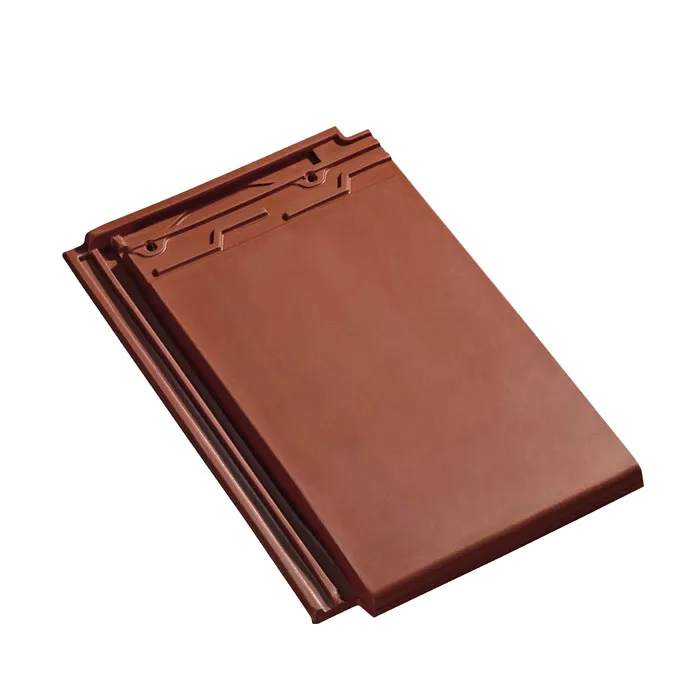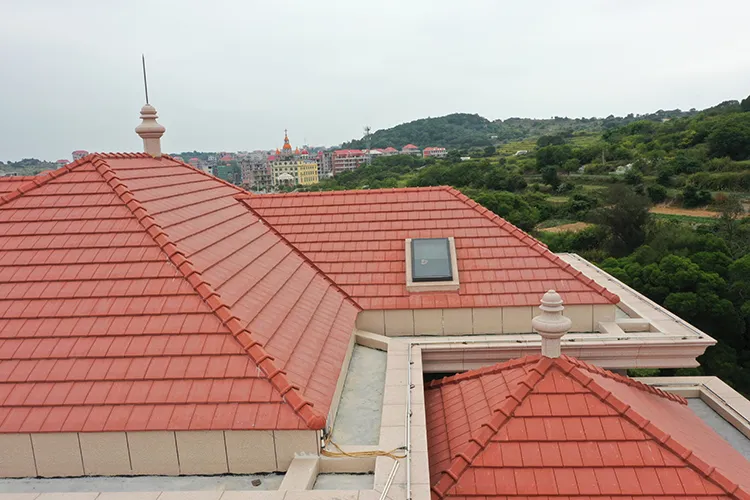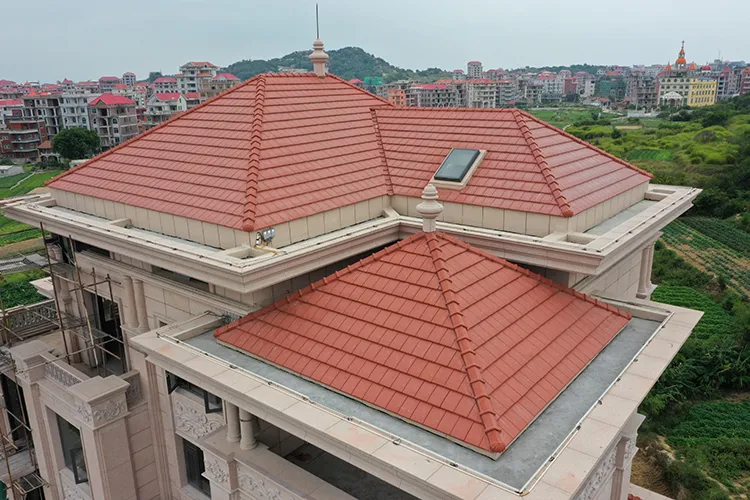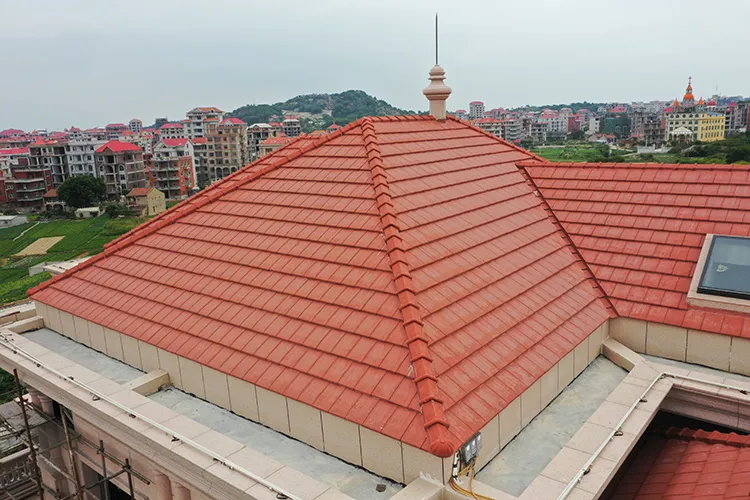Clay roof tiles and cement tiles are two of the most common choices for roofing materials today. Both are durable, waterproof and beautiful, and are indispensable roofing materials in many construction projects. However, for many homeowners and architects, choosing between clay roof tiles and cement tiles often becomes a difficult question. So, are clay roof tiles really better than cement tiles? What are the differences between the two? This article will provide a detailed analysis from multiple angles to help readers better understand the characteristics and differences of the two materials and make a wise choice.

What's the difference between clay roof tiles and cement tiles?
Clay roof tiles and cement tiles: Differences in materials and processes
The process of making clay roof tiles
Clay roof tiles is a natural material made mainly of clay and water. After the clay is processed through steps such as excavation, filtration, and mixing, it is sent into molds and pressed into tile shapes. Next, these tiles are sent to high-temperature kilns for firing to achieve a certain hardness and durability. After this process, the clay roof tiles not only have high strength, but also retain natural water absorption and air permeability, which can regulate the humidity and temperature of the roof well.
The color of clay roof tiles mainly depends on the mineral composition in the clay and the temperature during firing. Without adding any chemical pigments, the color of clay roof tiles is usually natural red or brown. Therefore, clay roof tiles add natural beauty to the roof with its natural color and unique texture.
Manufacturing process of cement tiles
Unlike clay roof tiles, the main raw materials of cement tiles are cement, sand and water. Cement and sand are mixed in a certain proportion to form a wet mixture. Next, the mixture is pressed into a tile shape and dried in the air or hardened at low temperature. After a period of curing, cement tiles have strong hardness and durability.
The color of cement tiles is mainly achieved by adding colorants, so the color selection of cement tiles is relatively wide. However, since the colorant is added to the surface of the tile, after a long period of wind and sun, the color of cement tiles may gradually fade and lose its original luster.

Clay roof tiles and cement tiles: Differences in durability
Strength and durability
Strength and durability are crucial factors in the selection of roofing materials. Both clay roof tiles and cement tiles have high strength and can withstand certain external forces. However, in long-term use, clay roof tiles and cement tiles perform slightly differently.
The firing process of clay roof tiles gives them high hardness and can withstand long-term wind and sun, especially in high temperature and extreme weather conditions. Because clay roof tiles have good chemical resistance, they are more resistant to acid rain and salt erosion. Therefore, clay roof tiles are particularly suitable for use in coastal areas or environments with severe air pollution.
In contrast, the durability of cement tiles depends mainly on their manufacturing process and the quality of the raw materials. High-quality cement tiles can also have strong wind resistance and pressure resistance, but cement tiles are generally not as chemically resistant as clay roof tiles. The surface of cement tiles may weather over time, especially when exposed to moisture and acidic environments for a long time, and the strength of cement tiles may gradually decrease.
Water absorption and frost resistance
Clay roof tiles and cement tiles also differ in terms of water absorption and frost resistance. Clay roof tiles have a certain degree of water absorption due to their naturally porous structure, which allows them to absorb some rainwater and regulate the humidity of the roof. However, modern high-quality clay roof tiles have been specially treated to significantly reduce their water absorption. Even so, clay roof tiles still retain good breathability, which allows them to stay dry in hot and humid climates and reduce the growth of mold and algae.
Cement tiles generally have a higher water absorption rate than clay roof tiles. This is because cement tiles have more micropores on their surface and are more likely to absorb water. In cold climates, the water absorbed by cement tiles may freeze, causing the tiles to expand and crack. Therefore, special attention should be paid to the waterproofing of cement tiles when using them in cold regions.
Weight
The weight of the tiles is an important consideration in roof design. Both clay roof tiles and cement tiles are relatively heavy, but cement tiles are generally heavier than clay roof tiles. This means that the roof structure needs to have a stronger load-bearing capacity when using cement tiles. If the roof structure is not strong enough, it may need to be reinforced to avoid structural problems caused by the weight of the tiles.
Clay roof tiles are relatively light in weight, so they have relatively low requirements for the roof structure. In some older buildings, choosing clay roof tiles can avoid large-scale modifications to the existing roof structure.

Clay roof tiles and cement tiles: Differences in appearance
Natural beauty vs. modern look
Clay roof tiles are known for their natural color and texture. Since the color of clay roof tiles comes from natural minerals, its color will not fade over time. Instead, the color of clay roof tiles gradually becomes softer with the natural weathering process, giving the roof a unique rustic beauty. Therefore, clay roof tiles are often used in historical buildings, country-style homes, and buildings that pursue natural beauty.
Cement tiles are known for their modern look and diverse color options. Since the color of cement tiles is achieved by adding pigments, a variety of colors and patterns can be selected according to the design style of the building and the preferences of the homeowner. However, the color of cement tiles is easily affected by weather and fades, especially when exposed to strong ultraviolet rays, the color of the tiles may become dull.
Surface texture
The surface of clay roof tiles usually has a natural rough texture, giving people a sense of returning to nature. Since clay roof tiles form irregular textures during the firing process, each tile has a unique handmade feel. In contrast, cement tiles have a smoother surface and more regular lines, presenting a modern and simple style.
When choosing roofing materials, homeowners and architects can decide whether to choose clay roof tiles with a more natural beauty or cement tiles with a stronger sense of modernity based on the overall style and aesthetic needs of the building.
Clay roof tiles and cement tiles: Differences in environmental protection
Environmental protection and sustainability are factors that are gaining more and more attention in today's construction industry. Clay roof tiles and cement tiles also perform differently in this regard.
Environmental protection of clay roof tiles
As a natural material, the production process of clay roof tiles is relatively environmentally friendly. Clay is widely available and will not have much impact on the environment if it is properly managed and mined. In addition, clay roof tiles do not require the addition of chemicals during the production process, and the firing process also produces less waste gas and wastewater. Therefore, clay roof tiles are regarded as an environmentally friendly building material.
Clay roof tiles have a long service life, often lasting 50 years or more. This long life also makes clay roof tiles more environmentally friendly overall, as less replacement and maintenance means less resource consumption and waste generation.
Environmental friendliness of cement tiles
The production of cement tiles involves the manufacture of cement, which is a high-energy and high-emission process. The carbon dioxide produced in cement production has a greater impact on the environment, so from an environmental perspective, cement tiles are not as environmentally friendly as clay roof tiles.
However, cement tiles are more efficient to produce, the material supply is sufficient, and their production process is relatively fast and low-cost. Therefore, cement tiles are still widely used in the construction industry.

Clay roof tiles and cement tiles: maintenance differences
Maintenance of clay roof tiles
The natural resistance of clay roof tiles to weathering makes them less maintenance-intensive. However, the brittleness of clay roof tiles makes them prone to cracking when subjected to external impact. Therefore, care needs to be taken to avoid physical damage to the tiles during installation and daily use. Regular inspections of the roof to ensure that the tiles are not damaged or displaced can extend the service life of clay roof tiles.
Maintenance of Cement Tiles
The surface of cement tiles is susceptible to weathering and fading over time. Therefore, the surface of cement tiles may require regular cleaning and maintenance to maintain its beauty. In addition, the waterproof performance of cement tiles may gradually deteriorate in cold climates, so the condition of the waterproof layer needs to be checked regularly.
As a global leader in the building materials sector, Rongguan manufactures a wide range of premium quartz, artificial marble, and roofing materials. Our extensive facility in Foshan enables us to produce customized materials that meet the demands of clients worldwide. With competitive prices and wholesale rates, we are a top choice for construction projects of all sizes. We also offer discounted prices for large-volume purchases. Reach out to us for quotes and promotions and experience the quality of Rongguan materials for yourself.

